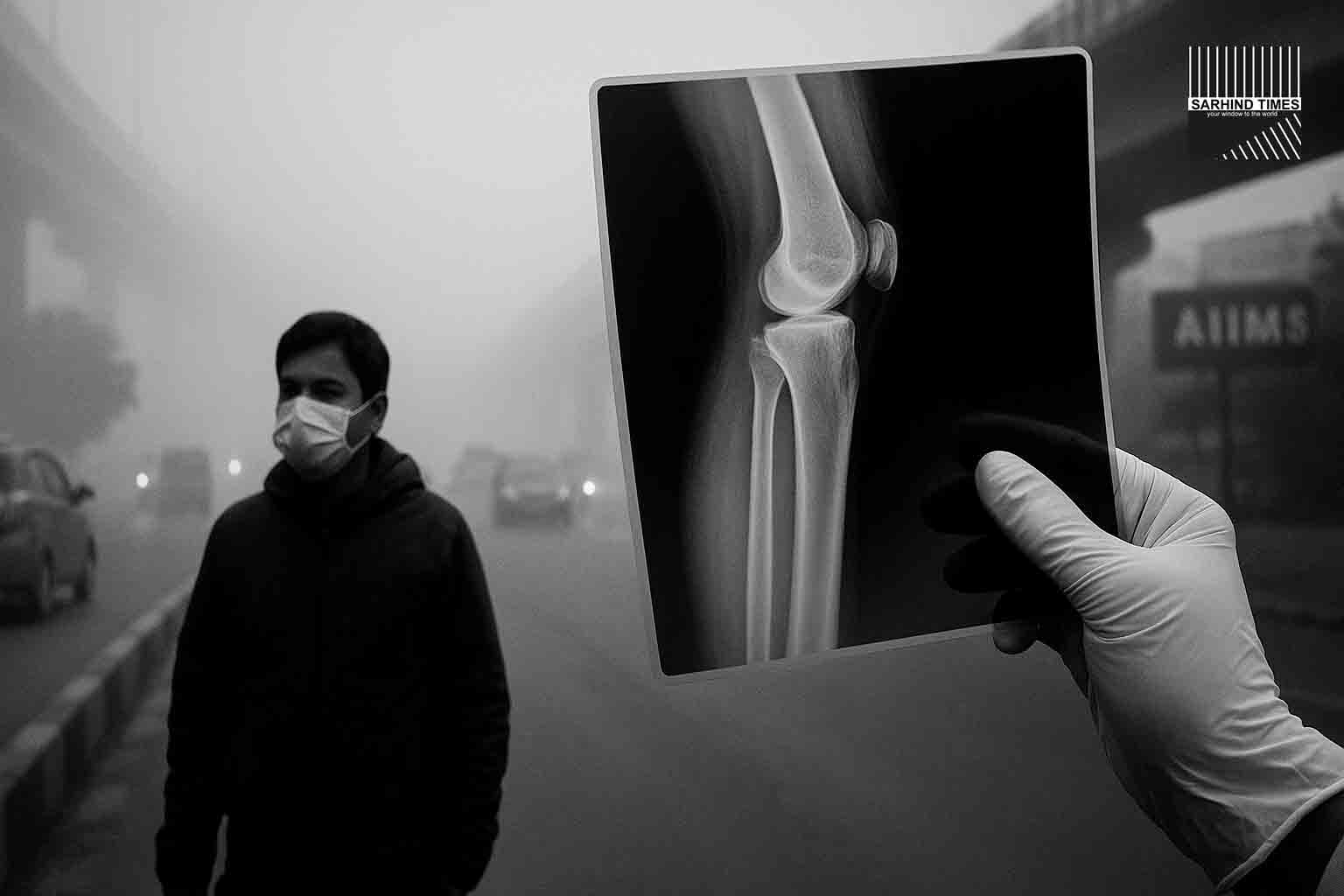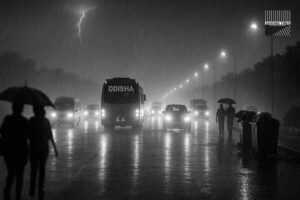At IRACON 2025, leading rheumatologists warned that toxic air, particularly PM2.5 exposure, may be triggering a spike in rheumatoid arthritis across Delhi and adjoining regions — expanding the pollution debate beyond lungs and hearts.
By SarhindTimes Health Bureau
New Delhi, October 2025
A New Face of Air Pollution
For decades, Delhi’s smog has been blamed for asthma, chronic bronchitis, and heart disease. But this year, rheumatologists have added a new name to the list — rheumatoid arthritis (RA).
At the Indian Rheumatology Association’s annual conference (IRACON 2025), experts from AIIMS, Fortis, and Apollo Hospitals presented data showing a sharp uptick in RA cases across the National Capital Region, many among patients with no family history of the disease.
The cause, they suggest, may lie in the very air Delhi breathes.
“We’re seeing young, non-smoker patients developing joint pain and autoimmune inflammation without genetic predisposition,”
said Dr. Uma Kumar, Professor and Head of Rheumatology at AIIMS, New Delhi.
“The common denominator appears to be prolonged exposure to particulate matter — especially PM2.5.”
Pollution’s Invisible Inflammation
Rheumatoid arthritis is a chronic autoimmune disorder in which the immune system mistakenly attacks the body’s own joints, leading to swelling, pain, and progressive deformity. Traditionally, genetic and lifestyle factors have dominated the conversation.
But clinicians now argue that air pollution may act as a biological trigger — one that ignites dormant inflammation pathways.
Mechanisms under study include:
- Oxidative stress caused by fine particulate matter entering the bloodstream
- Immune dysregulation induced by chronic inflammatory cytokines
- Epigenetic changes that “turn on” autoimmunity genes even in those without family history
“Air pollutants don’t just stay in the lungs,”
explained Dr. Amita Aggarwal, Senior Consultant, SGPGIMS Lucknow, speaking at IRACON.
“PM2.5 can cross the alveolar barrier, circulate systemically, and disrupt immune balance — pushing predisposed individuals toward autoimmunity.”
Delhi’s Air: A Perfect Storm
Delhi’s Air Quality Index (AQI) has hovered between ‘poor’ and ‘very unhealthy’ since early October, with PM2.5 concentrations exceeding safe limits by five to six times.
The capital’s winter months see a seasonal cocktail of emissions — vehicle exhaust, industrial pollutants, construction dust, and crop-residue burning — turning the atmosphere into a toxic incubator for inflammation.
“Each winter, we brace for respiratory spikes. Now we’re preparing for joint pain spikes too,”
said Dr. Rajesh Malhotra, orthopaedic surgeon at AIIMS.
“It’s not anecdotal anymore. We’re seeing clusters of new autoimmune cases that correlate with worsening air quality.”
The Numbers Behind the Concern
While India lacks large-scale national surveillance on pollution-linked autoimmune diseases, localized hospital data paints a worrying picture.
- AIIMS reported a 30% rise in first-time RA consultations between 2022 and 2025.
- Fortis Gurgaon and Apollo Delhi both recorded an increase in young, urban women presenting with joint inflammation over the last 18 months.
- The Indian Council of Medical Research (ICMR) has now initiated a multicentre study to track immune biomarker patterns among Delhi-NCR residents versus cleaner-air regions like Shimla and Coimbatore.
If proven, the link could reshape how India frames its air pollution crisis — from a respiratory issue to a systemic public health emergency.
Voices from the Ground: Patients of the City’s Air
For 35-year-old Kavita Mehra, a marketing executive from Noida, the symptoms began last winter — morning stiffness in her fingers, mild swelling, fatigue.
“At first, I thought it was just the cold,” she says.
“But when I couldn’t hold a coffee mug without pain, I knew something was wrong.”
Her diagnosis: early-stage rheumatoid arthritis.
Kavita doesn’t smoke, exercises regularly, and has no family history of the disease. Her rheumatologist suspects long-term exposure to Delhi’s polluted air as the trigger.
“When the air is this toxic, it’s not just about lungs — it’s a full-body assault,” says Dr. Mehra’s treating physician at Fortis.
From Rheumatology to Policy: The Air–Immunity Nexus
The IRACON panel urged authorities to integrate autoimmune monitoring into Delhi’s annual health surveillance plan.
“We need to treat bad air as an immune disruptor, not just a respiratory hazard,”
said Dr. Arvind Chopra, former president of the Indian Rheumatology Association.
Experts propose a cross-sector health framework, combining medical data, environmental monitoring, and urban policy.
Recommendations include:
- Funding air-to-health impact studies under ICMR and CPCB collaboration.
- Real-time hospital dashboards correlating patient spikes with AQI trends.
- Special health advisories for sensitive autoimmune-prone populations during severe air days.
The Science: How PM2.5 Alters Immunity
PM2.5 — particulate matter smaller than 2.5 microns — is small enough to penetrate deep into lung tissue and cross into the bloodstream. Once inside, it triggers a cascade of pro-inflammatory molecules such as TNF-alpha, IL-6, and CRP.
These inflammatory mediators are the same chemicals responsible for joint erosion in rheumatoid arthritis.
“Chronic exposure acts like a slow poison,” said Dr. Soumya Narayan, immunologist at Apollo.
“It keeps the immune system on red alert, leading to misguided attacks on healthy tissue.”
Recent studies from China and Italy support this connection. Cities with sustained high PM2.5 levels reported higher RA prevalence, even after adjusting for genetic and occupational factors.
The Broader Health Picture
The National Health Profile 2024 already warned that Delhi’s pollution-related disease burden extends beyond traditional illnesses. Autoimmune thyroid disorders, lupus, and multiple sclerosis have shown correlative upticks in northern states during high-smog seasons.
“The body doesn’t compartmentalize pollution,”
said Dr. Ritu Arora, AIIMS Delhi.
“It’s the same bloodstream carrying toxins to every organ — from lungs to joints to the brain.”
She added that early diagnosis and adherence to disease-modifying therapies (DMARDs) can prevent irreversible damage, even as pollution remains an aggravating factor.
Policy Vacuum: From Advisories to Accountability
While Delhi routinely issues smog alerts and school closure advisories, health experts argue these are short-term optics.
“We’ve normalized pollution as a seasonal nuisance,”
said Dr. A.K. Nair, senior consultant at Medanta.
“But this is a chronic, multi-organ emergency. Autoimmunity is only the latest warning signal.”
Doctors called for immediate structural interventions:
- Crop-residue management through bio-decomposers and incentive schemes.
- Stricter vehicular emission audits, particularly for diesel fleets.
- Cleaner domestic fuels and construction dust control.
- Inclusion of autoimmune data in Delhi’s annual health report.
A Call for Preventive Care
Rheumatologists emphasized that while policy takes time, individuals can take immediate preventive measures:
- Wear N95 masks on high-AQI days.
- Use indoor air purifiers and maintain ventilation hygiene.
- Avoid outdoor exercise during smog hours.
- Undergo early RA screening if persistent joint pain lasts beyond 6 weeks.
“The earlier we intervene, the more we can preserve mobility and quality of life,”
said Dr. Nisha Dutta, Fortis Noida.
A National Wake-Up Call
The IRACON report reverberated beyond Delhi, sparking concern among health officials in other metros. Mumbai, Lucknow, and Gurugram have also reported parallel spikes in autoimmune consultations.
Public health experts urge a nationwide framework for clean air as preventive medicine, akin to vaccination drives.
“Air quality improvement should be seen as a non-communicable disease strategy,”
said Dr. Randeep Guleria, former AIIMS Director.
“Cleaner air could lower rates of diabetes, arthritis, and even neurological disease.”
Editorial Insight: The Cost of Delay
Delhi’s “pollution season” has become a grim annual ritual — masks, air purifiers, warnings, outrage, and amnesia. But the rheumatologists’ warning may finally crack the public’s complacency.
If bad air is altering immune systems, then the crisis is no longer atmospheric; it’s biological.
The implications are staggering: a generation developing preventable chronic diseases not from genes, but geography.
In that sense, the real emergency is not in the skies — it’s in the bloodstream of Delhi’s residents.
Conclusion: Beyond Breathing — A Fight for Every Organ
Rheumatologists at IRACON 2025 didn’t mince words: Delhi’s air is eroding not just lungs but lives.
If unchecked, the toxic cloud hovering over NCR could soon become a national autoimmune experiment.
For policymakers, the takeaway is clear — cleaning the air is healthcare.
And for citizens, awareness is the first line of defense.
“It’s time we stop calling it smog season,” said Dr. Uma Kumar.
“This is disease season — and the cure begins with clean air.”
#AirQuality #DelhiNCR #Health #Rheumatology #PM25 #PublicHealth #CleanAir #AutoimmuneDisease #MedicalNews #SarhindTimes






















+ There are no comments
Add yours